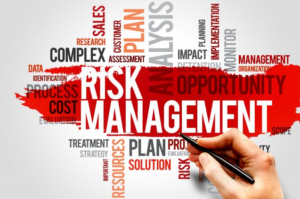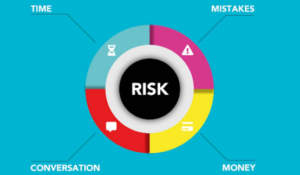Business Risk Management Solutions – In today’s fast-paced business world, risks are inevitable, but the good news is that effective Business Risk Management Solutions can help you identify, assess, and mitigate these risks. Whether you’re a startup or a large enterprise, investing in risk management tools is essential to protect your assets, improve decision-making, and ensure long-term growth.
This article will dive deep into the top business risk management tools, exploring their features, benefits, and real-world examples to help you make an informed decision for your business. Ready to safeguard your business? Let’s get started!
What is Business Risk Management?

Business risk management involves identifying potential threats to an organization and implementing strategies to minimize or eliminate those risks. These risks can come from various sources, such as:
- Financial Risks (e.g., market fluctuations, investments)
- Operational Risks (e.g., supply chain disruptions, equipment failure)
- Compliance Risks (e.g., regulations, data breaches)
- Strategic Risks (e.g., competition, market entry)
The goal of business risk management is to protect a company’s assets and ensure that it continues to operate smoothly, even when faced with uncertainties. This is where modern risk management solutions come into play, providing businesses with real-time insights, automation, and predictive analytics to tackle potential problems before they escalate.
Benefits of Using Risk Management Solutions
Implementing the right risk management tools offers numerous advantages for businesses, including:
- Proactive Risk Detection: These solutions allow businesses to identify potential risks before they become significant issues, enabling early intervention.
- Cost Reduction: By mitigating risks early, companies can avoid costly disruptions, fines, or legal liabilities.
- Compliance & Governance: Many industries have strict regulations. Risk management software ensures compliance with regulatory standards, preventing penalties.
- Enhanced Decision-Making: With better visibility into potential risks, businesses can make smarter, data-driven decisions.
- Increased Efficiency: Automated tools reduce the manual effort required to monitor and manage risks, saving time and resources.
Top 5 Business Risk Management Solutions in 2024

Here are some of the leading business risk management solutions that can help your organization stay ahead of the curve.
1. Resolver
Resolver is a comprehensive risk management tool that integrates risk, audit, and compliance management into one platform. It’s ideal for businesses of all sizes and helps monitor and manage risks with ease.
- Features:
- Risk assessments and incident tracking
- Internal audit management
- Compliance management
- Data visualization dashboards
- Pros:
- Easy to use with a highly customizable dashboard
- Seamless integration with other tools
- Scalable for both small and large enterprises
- Cons:
- Steep learning curve for beginners
- Price: Custom pricing (depends on business size)
2. RiskWatch
RiskWatch offers a powerful platform for evaluating, assessing, and mitigating risks. It’s particularly known for its strong reporting features and AI-driven risk assessments.
- Features:
- AI-driven risk assessments
- Customizable reporting
- Automated compliance tracking
- Incident management
- Pros:
- AI-powered risk prediction
- Comprehensive compliance management
- Strong focus on reporting
- Cons:
- Limited integration options with other platforms
- Price: Starts at $99/month
3. LogicManager
LogicManager is a top-rated solution for risk management, known for its ease of use and robust features. It provides end-to-end risk management and compliance for businesses of any size.
- Features:
- Risk assessments and reporting
- Compliance tracking
- Workflow automation
- Vendor risk management
- Pros:
- User-friendly interface
- Excellent customer support
- Affordable for small and medium-sized businesses
- Cons:
- May require additional configuration for advanced users
- Price: Starting from $1,000/year
4. SAP GRC
SAP GRC (Governance, Risk, and Compliance) is a robust tool used by large enterprises to manage complex risk environments. It’s designed to streamline the risk management process and ensure regulatory compliance.
- Features:
- Advanced risk analytics and reporting
- Compliance tracking and audits
- Integrated governance solutions
- Automation of risk-related tasks
- Pros:
- Extremely powerful for large organizations
- Seamless integration with SAP ecosystem
- Extensive reporting features
- Cons:
- Expensive for small businesses
- Price: Custom pricing for enterprises
5. MetricStream
MetricStream is another top-tier risk management tool that caters to large organizations. It provides advanced analytics and real-time reporting, ensuring businesses stay compliant and aware of potential threats.
- Features:
- Real-time risk monitoring
- Advanced analytics and data visualization
- Compliance management
- Predictive analytics for risk forecasting
- Pros:
- Advanced AI capabilities
- Ideal for complex business environments
- Great for multi-national organizations
- Cons:
- High price point for small companies
- Price: Custom pricing (tailored to large enterprises)
Comparison Table: Top Business Risk Management Solutions
| Solution | Use Case | Pros | Cons | Price | Features |
|---|---|---|---|---|---|
| Resolver | All-in-one risk management for SMBs | Customizable, scalable | Learning curve | Custom Pricing | Risk assessments, compliance, incident tracking |
| RiskWatch | AI-driven risk management for all businesses | AI-powered, strong reporting | Limited integrations | $99/month | AI risk assessments, compliance, incident management |
| LogicManager | Comprehensive risk management for SMBs | User-friendly, affordable | May require customization | $1,000/year | Workflow automation, vendor risk management, compliance |
| SAP GRC | Enterprise-level risk management | Advanced analytics, SAP integration | Expensive for SMBs | Custom Pricing | Governance, risk forecasting, compliance |
| MetricStream | Multi-national, large enterprise risk solution | Real-time risk monitoring, predictive | Expensive | Custom Pricing | Predictive analytics, real-time reporting, compliance |
Why You Should Invest in Business Risk Management Solutions

If you’re still on the fence about investing in risk management solutions, here are some real-world use cases to consider:
1. Proactive Risk Detection and Mitigation
One of the most critical benefits of risk management solutions is their ability to identify risks before they become full-blown problems. With advanced data analytics and real-time monitoring, these tools allow businesses to:
- Spot vulnerabilities early: Whether it’s a potential data breach or operational inefficiency, risk management software alerts you to problems before they escalate.
- Prioritize risk response: Based on the severity of potential threats, you can allocate resources more efficiently to address high-priority risks.
By being proactive, your company can reduce disruptions, safeguard assets, and minimize the impact of unforeseen events.
2. Improved Compliance and Regulatory Governance
With increasing regulations in many industries—such as GDPR, SOX, or HIPAA—staying compliant is crucial to avoiding hefty fines and reputational damage. Risk management solutions ensure that your business meets all necessary compliance standards by offering features such as:
- Automated compliance tracking: This ensures that you’re always aligned with regulatory updates, reducing the risk of penalties.
- Centralized documentation: All regulatory requirements are stored in one place, making audits smoother and less time-consuming.
Solutions like SAP GRC and Resolver are ideal for managing regulatory compliance, enabling businesses to maintain governance efficiently.
3. Cost Reduction and Financial Security
Unchecked risks can lead to costly outcomes, from operational downtime to data breaches. With risk management solutions, you can reduce the financial impact of potential threats by:
- Preventing operational disruptions: By monitoring risks in real-time, businesses can avoid costly shutdowns, equipment failures, or supply chain issues.
- Minimizing legal liabilities: With proper compliance tracking, the risk of lawsuits or penalties is drastically reduced.
Investing in a comprehensive risk management solution ultimately saves your business money by avoiding large-scale damages and operational inefficiencies.
4. Enhanced Decision-Making with Data-Driven Insights
Risk management solutions provide detailed data analytics and predictive modeling, helping you make smarter, more informed business decisions. Key insights include:
- Trend analysis: Track the historical performance of certain risks and predict future threats.
- Scenario planning: Simulate potential risks and evaluate the best responses to those scenarios.
For instance, tools like MetricStream offer real-time risk analysis, giving you deeper insights into which risks pose the most significant threat to your business.
5. Increased Operational Efficiency
Traditional risk management can be a time-consuming and manual process. By automating key tasks such as risk identification, reporting, and compliance monitoring, businesses can:
- Reduce administrative overhead: Automation frees up resources and reduces the need for manual data entry and monitoring.
- Streamline processes: Teams can work more efficiently by following clear risk mitigation workflows.
Using tools like LogicManager or RiskWatch, businesses can enhance their operations, making risk management an integrated part of their everyday processes.
How to Buy the Best Risk Management Tool
Purchasing the right Risk Management Tool is a crucial decision for any business. The tool you select should align with your business needs, offer scalability, and provide essential features for identifying, analyzing, and mitigating risks. Here’s a step-by-step guide to help you choose the best risk management solution for your organization:
1. Assess Your Business Needs
Before purchasing a risk management tool, start by evaluating your business’s unique requirements:
- Industry-Specific Risks: Consider the specific risks that your business faces. For example, financial institutions will prioritize tools that address fraud and regulatory compliance, while manufacturing companies may need a focus on operational and supply chain risks.
- Size of Your Business: The size and complexity of your organization will determine whether you need a simple risk assessment tool or a comprehensive enterprise risk management solution.
- Compliance Needs: Depending on the regulations your business is subject to (e.g., GDPR, HIPAA), you’ll need a tool that includes compliance management features.
By understanding your specific needs, you can narrow down the list of tools that will deliver the most value.
2. Identify Key Features You Need
The best risk management tools should offer essential features that help your business manage risk effectively. Look for tools that provide the following:
- Risk Identification and Assessment: The ability to identify risks, assess their impact, and prioritize them based on severity.
- Automated Reporting and Dashboards: Real-time reporting and analytics are vital for making informed decisions. A centralized dashboard that provides a full view of risk metrics is an added bonus.
- Compliance Management: Ensure the tool helps your business remain compliant with regulations by automatically updating compliance policies and tracking audits.
- Scalability: Choose a solution that can grow with your business, offering additional features or modules as your business expands.
- Integration Capabilities: The tool should integrate seamlessly with your existing systems, such as ERP, financial management software, or data analytics tools.
3. Evaluate Pricing and Budget
Different risk management solutions come with various pricing models, typically based on:
- Licensing Fees: These could be either a one-time fee or a subscription model (monthly or yearly).
- User Access: Some platforms charge based on the number of users, so determine how many team members will need access.
- Additional Features: Advanced features like custom reporting, predictive analytics, and compliance tracking may come at an extra cost.
While it’s essential to find a tool that fits your budget, don’t compromise on key features. Consider the potential return on investment (ROI) a comprehensive tool could bring by reducing risks and saving your business money in the long term.
4. Research Product Reviews and Case Studies
Look for third-party reviews and case studies to see how well the tool has performed for other businesses. Pay attention to:
- User Feedback: Look for reviews that highlight the tool’s ease of use, customer support, and effectiveness in managing risks.
- Case Studies: These will show you how the tool has helped companies in similar industries and how it performs in real-world scenarios.
Websites like Gartner, Capterra, and TrustRadius are great places to find detailed product reviews and ratings.
5. Request Demos and Free Trials
Most vendors offer free trials or product demos. Use these opportunities to see how the tool functions in a real-world setting:
- Test Core Features: Assess whether the tool meets your essential needs like risk identification, assessment, and reporting.
- User Interface: Ensure that the tool is easy to use and accessible to your risk management team.
- Customization Options: Check how customizable the tool is to suit your company’s specific risk profiles and workflows.
During the trial, involve key stakeholders from different departments to gather a range of feedback on the tool’s usability and efficiency.
FAQs about Business Risk Management Solutions
- What is the best risk management tool for small businesses?
- LogicManager is a great option for small businesses due to its affordability and ease of use.
- Can I automate risk management tasks?
- Yes, many tools like MetricStream and SAP GRC offer automation for risk-related tasks, saving time and resources.
- How much do risk management tools cost?
- Prices vary depending on features and business size. For example, RiskWatch starts at $99/month, while SAP GRC offers custom pricing.
- What features should I look for in a risk management solution?
- Look for features like risk assessment, compliance tracking, incident management, and real-time reporting.
- Are there free risk management tools available?
- Some solutions offer free trials, but most comprehensive risk management tools require a subscription or custom pricing.
By investing in the right business risk management solutions, you can protect your company from unforeseen threats and make more informed decisions. Ready to get started? Check out the top tools mentioned above to find the best fit for your business needs.